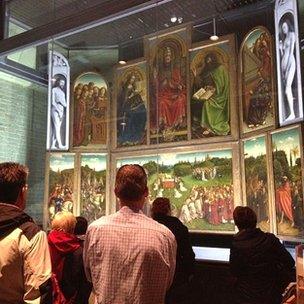Million-euro makeover for Belgium's Ghent Altarpiece
- Published
The altarpiece, by Flemish artist Jan Van Eyck, is almost 600 years old
It has been stolen at least six times, looted in three different wars, held for ransom, sold illegally and part of it is still missing.
Now Belgium's most famous painting, The Ghent Altarpiece, is being restored at a cost of more than 1m euros (£800,000; $1.3m).
Wearing a shiny black magnifying visor, conservator Bart Devolder, 33, looks somewhat futuristic as he surveys the dark, thick layers of oil paint that make up one of the most coveted art works in history.
"I feel privileged to be here," he says, gently touching the cracked surface.
"For people in Belgium, this is like the Mona Lisa. Or it is the equivalent of what the Sistine Chapel is to Italians. The Ghent Altarpiece is something special and I want my grandchildren to be able to see it too."
The painting is also known as the Adoration of the Mystic Lamb, because of the central panel which shows pilgrims clustered together to pay homage to the Lamb of God, a symbol for Jesus.
In total, 24 framed wooden sections make up the altarpiece, which was completed almost 600 years ago, by the Flemish artist Jan Van Eyck.
He is considered to be one of the most technical and talented artists of his generation, although it is widely believed that this piece of work was started by his brother Hubert Van Eyck.
Painstaking process
During the restoration project, Bart Devolder and his colleagues from Belgium's Royal Institute for Cultural Heritage will become exhibits themselves, because their work is taking place on public display, in a glass-fronted room inside Ghent's Museum of Fine Arts.
"It is very open, the windows are very big, and there will even be a webcam. It is one of the first times anything like this has happened in Belgium and, for now, it is a bit foreign to have visitors standing up against the glass," he laughs.
The restoration process will be a painstaking one, using chemicals to slowly remove old varnish that currently makes the painting appear darker and carefully retouching the most damaged areas.

Large photos replace the parts of the altarpiece that are being restored
"The job takes patience," says Mr Devolder. "I think we probably spend more time working on and looking at it than the painter did when he painted it!"
Original home
Unlike many of the world's masterpieces, which are hung in galleries or private collections, part of The Ghent Altarpiece's notoriety comes from the fact that it is displayed inside St Bavo's Cathedral, the painting's original home when it was commissioned in the 15th Century.
It is an elaborate building, complete with intricate medieval stone carvings, Gothic chandeliers and brightly coloured stained glass windows.
The museum restoration project will focus on a few panels at a time so that the rest can remain on show at St Bavo's, with large black and white photos replacing the parts that are temporarily missing.
"It absolutely exceptional to see [the Ghent Altarpiece] in the place it was made for, certainly if you take into account the enormous impact of history," says Anne van Grevenstein-Kruse, a retired professor of conservation and restoration at the University of Amsterdam, who is supervising the makeover.
"Napoleon took it to Paris. The side wings were sold to the art market in the middle of the 19th Century. In World War II, it was put in the Hitler museum. But now, it is here in the cathedral again.
"If you ask people about the painting, you will get a strong feeling of respect and identity. People from the city of Ghent feel that this altarpiece is theirs."
But do locals really love the painting enough to support the 1.4m-euro price tag on the restoration project, which is largely funded by Belgian taxpayers?
"I think it is cool that people here can see how the work is being done," says Arti Montenen, a Flemish student visiting the museum.
"It does seem like too much money to spend on just one artwork though."
Ms van Grevenstein-Kruse argues most people do view it as a worthwhile investment.
"Ninety-nine per cent of all tourists come to Ghent to visit the altarpiece. They have money and they invest in restaurants and hotels, and they keep the economy going," she says.
Cathedral conspiracies
Many visitors are actually most interested in seeing the newest part of the altarpiece, a replica of a section known as the Just Judges that was stolen in 1934 and never recovered. It was restored in 2010 by the Royal Institute for Cultural Heritage.
"The stories about the theft give us a lot of pleasure, it's like a national pastime," says Rudy Pieters, a local journalist who has written a book on the panel and organises tour guides on the conspiracies behind its loss.
He says there are theories that the original Just Judges is hidden in a nearby church, buried in a crypt underneath the cathedral and that it has been intentionally destroyed.
"A lot of people say it would be a pity if the missing panel turned up in the future, because the fact it is still missing keeps things mysterious, and keeps people coming," he jokes.
"But of course everybody really wants it to be found!"
Back at the museum, the team of restorers remain focused on the painting's most distant past.
Italian conservator Lydia Depuydt says once the restoration is complete, experts will have a much better idea of how Jan Van Eyck originally intended the altarpiece to look, although the colours will not be identical.
"Lots of people are waiting for this moment," she beams. "It will be a very special moment."
But with the project scheduled to take five years, the waiting game continues.